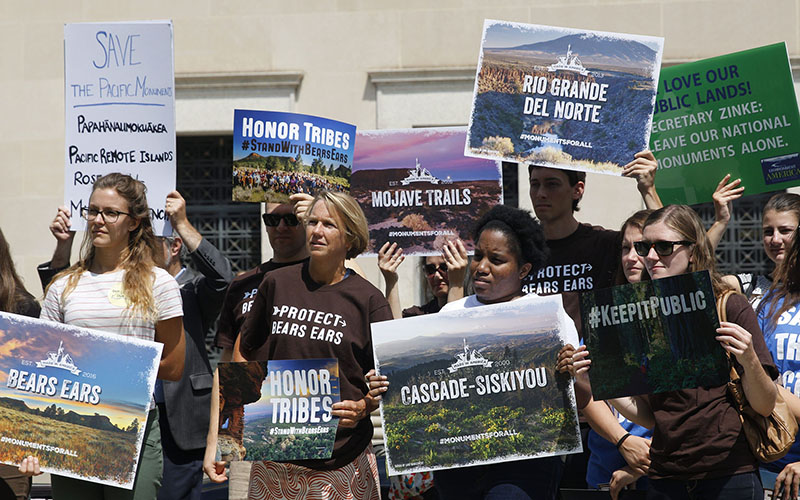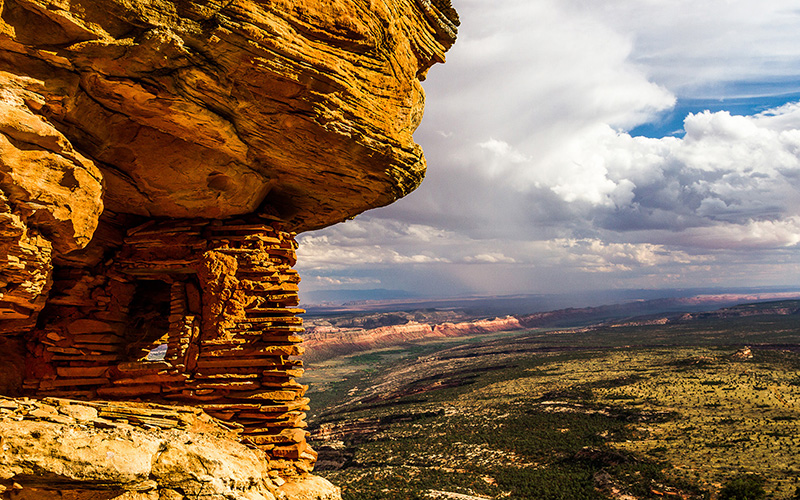
Protesters at the Department of the Interior hold signs of national monuments that could be affected by a White House-ordered review. Secretary Ryan Zinke said Thursday he will recommend keeping all current monuments, but downsizing a “handful.” (Photo by Andrew Nicla/Cronkite News)

Bears Ears National Monument, designated by then-President Barack Obama on Dec. 28, was cited specifically in President Donald Trump’s order for a review of monuments. Interior Secretary Ryan Zinke has said Bears Ears should be “right-sized.” (Photo by Josh Ewing/Bears Ears Coalition)
WASHINGTON – Interior Secretary Ryan Zinke said Thursday he will not call for the removal of any national monuments but will recommend downsizing an unnamed “handful” of monuments in a report to the White House.
The report follows a four-month review of national monuments that were created or expanded since 1996 by presidents invoking the Antiquities Act, in what critics have called an overreach of federal authority.
Environmental groups had feared that the review could lead to rescinding the designation of some monuments, including four in Arizona. While Zinke did not go that far, advocates said they will not declare victory until they see details of the plan, which had been sent to the White House but not released publicly Thursday.
Zinke did say in June that he thought the 1.5 million acre Bears Ears National Monument in southern Utah needed “right-sizing.” And in a summary of his report released by Interior, Zinke said there “is no doubt that President Trump has the authority to review and consider recommendations to modify or add a monument,” which has left environmentalists wary.
“Any recommendation from Secretary Zinke to shrink national monuments is hypocritical at best and ruinous at worst,” Sierra Club Executive Director Michael Brune said in a prepared statement.
But Rep. Rob Bishop, R-Utah, who has been a sharp critic of the Antiquities Act, commended Zinke for moving in an “encouraging” direction to get the law back on the right course.
“I am encouraged by the recommendations to revise previous designations that were inconsistent with the law and act outside the (Antiquity) act’s size limitations,” said Bishop, the chairman of the House Natural Resources Committee, in an emailed statement. “It is my hope that President Trump takes this opportunity to begin realigning uses of the law with its intended purpose.”
Bishop has been a particular critic of Bears Ears, which was cited specifically in the April 26 executive order by Trump ordering the review.
Bears Ears was designated on Dec. 28 by then-President Barack Obama, who used the Antiquities Act to declare 553.5 million acres as national monuments during his term, almost twice as many acres as all presidents combined since the act took effect under President Teddy Roosevelt. President George W. Bush was second, preserving 218.8 million acres during his administration.
The Antiquities Act, signed in 1906, gives the president the authority to designate national parks, and outlined punishments for the destruction of artifacts and antiquities on government or tribal property.
“The problem is the past few administrations have been using this (act) to control” large swaths of land, said Molly Block, a spokeswoman for the House Natural Resources Committee. “That was not the intent of the Antiquities Act – it was intended for the Wild West, when people were looting artifacts.”
-Cronkite News video by Fraser Allan Best
But supporters of the act have fought vigorously against any changes, citing not only the environmental and historic value of preservation but the economic benefits of national monuments on local communities.
The Friends of the Saguaro National Monument in May cited a study by the Outdoor Recreation Association that said “the outdoor recreation economy generates $887 billion in annual economic activity and is responsible for 7.6 million American jobs.”
That citation was also part of an April resolution calling for support of national monuments, including the four in Arizona that could have been affected by Trump’s executive order: Grand Canyon-Parashant, Vermilion Cliffs, Sonoran Desert and Ironwood Forest.
The Interior Department had received more than 2.8 million public comments on the review as of this week, and critics are still suspicious. One of the biggest criticisms of the review by supporters of the Antiquities Act is the possibility that special interests have been involved in the process.
William Snape, senior counsel for the Center for Biological Diversity, said that when Zinke finally reveals the lands he has targeted for reduction it will likely reflect the intent of those special interests.
“I will bet you anything that the lands they are going to reduce are based off of gas, oil and mining,” said Snape, who also teaches at American University’s Washington College of Law.
Bishop, who called on Congress to “restore integrity to” the law, said in a conference call Thursday that the only special interest groups involved in the discussion have been environmentalists as they fight the review. Claims like Snape’s are a distraction from the real issue, which he said was the abuse of process.
Block said the claim “that these lands are being opened up for oil and gas is blatantly false. Even if they were opened up in the future, it would be through public comment and take years.”